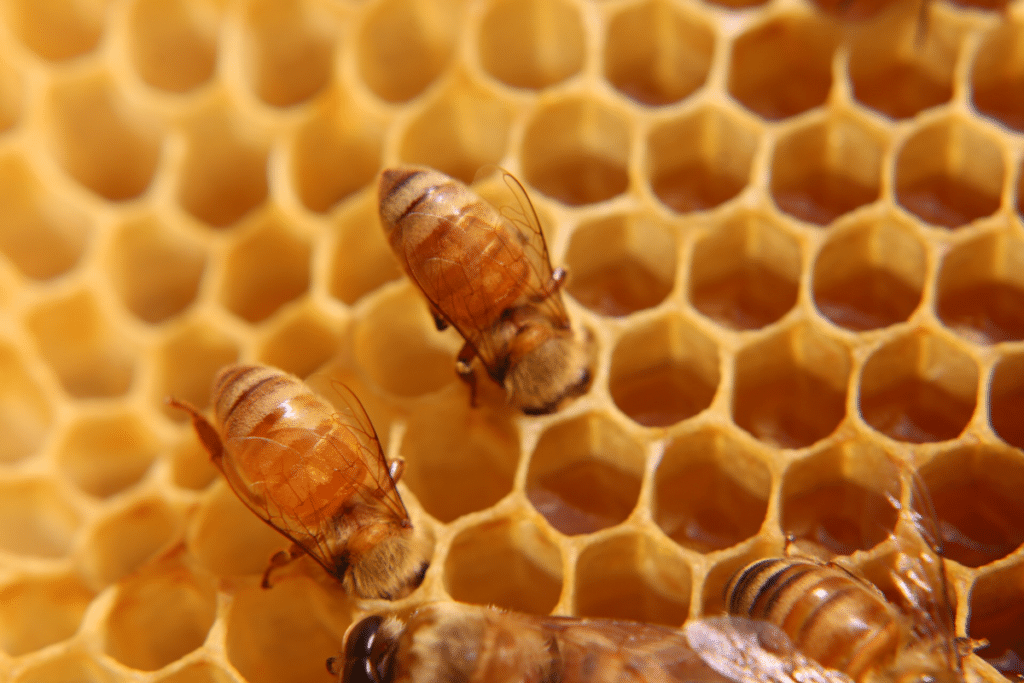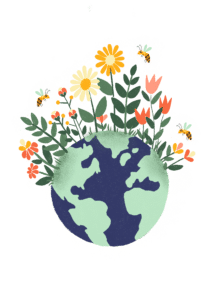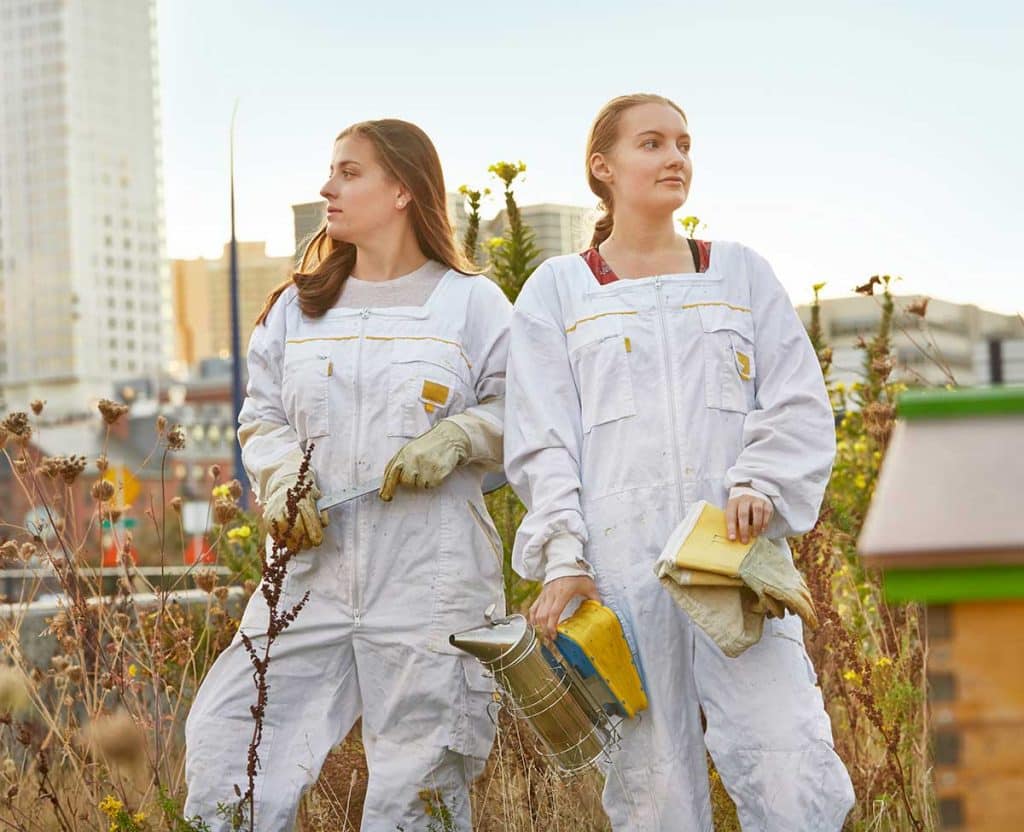Beehives are much more than just a box of bugs on your property. Beyond the direct benefits of food, flowers, and honey, bees also give us a view of life and of our planet that we wouldn’t otherwise be able to see. More importantly, bees serve as living data points that are part of a larger effort to save the bee populations and help us study the world.
During a recent webinar with our founder Noah Wilson-Rich and Darcy Gray, also a scientist (as well as a beekeeper) and a Fellow in the NASA DEVELOP Program, explore the importance of studying bees and how NASA is addressing environmental and policy concerns through the practical application of NASA Earth observations.
Why We Study Honeybees
Simply put, bees equal food. The fate of pollinators is tied directly to the security of our food system, nutrition, and human health. Beyond our own nutritional, economical, and emotional well-being, bees play a huge role in the reproduction of millions of other plant species. They make our planet thrive as we know it.
Plight of the Pollinators – Why Bees Are at Risk
Many people think of beekeeping as a hobby, but it is a field that is moving the global needle. With bee populations in a rapid decline throughout the world, it is more important than ever to pay attention to these vital pollinators.
According to our in-house bee scientist during a webinar with NASA, Noah Wilson-Rich, PhD, said, “Last year was the worst to date in the US: 44% of beehives didn’t survive the year, and we saw the highest ever recorded summertime deaths.”
The four known reasons for the decline in the bee population can be contributed to the following:
- Disease
- Pesticides
- Habitat loss
- Climate change
Studying beehives can help fight against the reasons for the decline in bee population. For example, to monitor disease [in this case Varroa mite infestations], grassroots efforts like “mite-a-thons” rally recreational and professional beekeepers nationwide to report mite levels in their beehives. As a result, we’re able to track the spread of disease and test out promising new treatments.
What We Can Learn From Studying Bees
No single data point can prove a theory. No single beehive can represent the species. And no single person or company can save the bees alone. In order to achieve this scientific progress takes a collective effort.
We’ve seen this collective effort take place with the emphasis on corporate social responsibility and environmental governance targets, and other businesses favoring the impact and value of sustainability.
By studying bees, we can make a measurable impact to drive real change on accomplishing goals relating to:
- Biodiversity, disaster recovery, and climate change;
- Social dynamics (specialized divisions of labor) help us understand the survival of bee populations;
- And the spread of plagues and disease.
What’s the Scientific Value?
Bees are known as indicator species. Honeybees are one of 20,000 species of bees and 200,000 species of pollinators. They are considered an indicator species because their health correlates to pollinator health overall. Honeybees in particular are a great species to study because they return to their hives each night and are extremely docile. The honey that is produced can tell us a lot about the biodiversity of the local habitat.
Honeybees are more social than other domesticated pollinators. This organized social structure provides insight into their health as a whole. They’re also considered a superorganism, meaning together, each bee in the hive functions as a single unit. This allows for an easier assessment of the overall health of the population
The scientific value can be understood by the superorganism theory. It provides a vast perspective of understanding the spread of plagues, conflict and cooperation across groups of bees, and what factors are associated with the health and success of populations.
What Helps Bees Thrive?
NASA Earth observation data gives us a new way to understand pollinator health, and also allow us to shift our perspective on a more viable environment.
Aside from the scientific data on bees, there’s a ton of innovation happening in the field. The innovation is contingent upon the evolving of state-of-the-art beekeeping, where each beehive is a data point. Within this model, hives are living barometers of climate change.
Another trend in favor of the bees’ prognosis is a surge of interest in beekeeping among young and diverse talent around the world. Beekeepers aren’t just old, white men in suits anymore. We feature next-gen beekeepers on our blog and they truly are future changemakers.
Beekeepers in the field.
With this infusion of energy, new perspectives, lots of data, and access to cool technology, we can see where pollinators are dying and where they are thriving. And as a scientific community, we can start to draw conclusions about biodiversity and climate change.
We’ve applied the NASA DEVELOP algorithm to help us to better understand what bees are experiencing on the ground, for example, to know what plants they were foraging on, and how this relates to their health. It’s one thing to better know where bees are thriving, but the next step is for us to understand why.
Biodiversity refers to the variety of living species on Earth, including plants, animals, bacteria, and fungi. A healthy ecosystem has a rich level of biodiversity. We decided to do a deep dive into the biology of honey, sequencing the genomes of pollen found in the honey we harvested from our client beehives. It’s called honeyDNA and Best Bees is the only company to offer this analysis.
By taking a scientific approach to beekeeping, we are taking strides toward that goal—and in the process, securing our food system, pollinating our gardens, harvesting delicious local honey, and supporting research into many important facets of life on earth.
What You Can Do to Protect Bees
If the environment, plantlife, and food access are important to you, here are a few tangible things that you can do to protect and preserve the future bee populations.
Advocate for bees
Use your voice and your social media channels to share information about bees. Look around at the physical spaces and resources you have, and what can be done with them. If you’re just starting your advocacy for the bees, here are 5 things you can do to save the bees right now.
A backyard area and vacant corner on a rooftop can leave a lasting impact. Ask your employer,
“What are you doing with that empty space?
Let’s turn it into a small garden or pollinator habitat.”
Plant Native Wildflowers
Even though we’re in the thick of autumn and we don’t usually think of planting flowers this time of year, there are still things you can do. Planting now will yield flowers in the spring. You don’t have to wait. For more on what to plant, you can visit this blog post.
If you don’t think of yourself as a gardener, try guerilla gardening- take a handful of native wildflowers, throw them in a vacant lot, and see what grows! We can all help improve the green-ness of our local ecology no matter where we are, no matter your age or ability.
Get Bees
Professionally-managed beehives are a low-maintenance, high-impact option for those interested in expanding the bee population. Each beehive managed by The Best Bees team adds to the larger dataset for ongoing research. Even the beehives that die still provide data and are still valuable to science. The fact that a hive does not survive tells us something.
Or, you can take a local beekeeping class and do it yourself. Don’t neglect your hives. Remember you’re doing your part to create a better tomorrow.
Get honeyDNA Reports
honeyDNA now informs us about the plant environment surrounding beehives, measuring ecosystems like never before, using advanced genomics to look at DNA, just like AncestryDNA or 23 and Me do for humans. This data actually informs disaster preparedness efforts, identifies the presence of invasive species, and serves as tasting notes for your next cup of tea. HoneyDNA lets you learn what your bees like in your area. If you don’t have beehives, you can get this analysis for a friend and spread awareness throughout your local community.
Use NASA’s Data
For both the professional scientists and citizen scientists reading this, tap into ARSET. ARSET is NASA’s Applied Remote Sensing Training resource. It covers the basics, for those who have never touched it before, to more advanced topics, and includes live and on-demand, free webinars. This resource is for anyone who wants to learn how to use satellite data to investigate questions about almost anything!
One of our next projects is to overlay HoneyDNA data with satellite data, so that beekeepers can start to understand what we can do to transform habitats to improve pollinator health, perhaps by promoting a wider variety of native plants in areas where bees are not doing well.
The Best Bees Company wants to empower you with ideas for how to support this research and join Best Bees’ mission to save the bees. Remember, it takes a village to save the bee population.
Resources:
DEVELOP: https://develop.larc.nasa.gov/
HIVE-OS: https://github.com/NASA-DEVELOP/HIVE-OS
Native Plant Finder: https://www.nwf.org/nativeplantfinder/
Pollinator Conservation Seed Mixes from Xerces Society: https://xerces.org/pollinator-conservation/pollinator-conservation-seed-mixes









